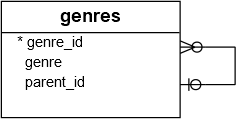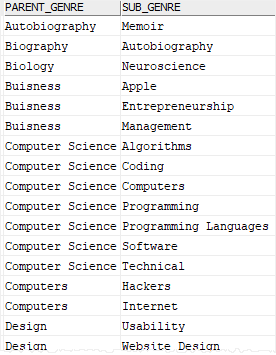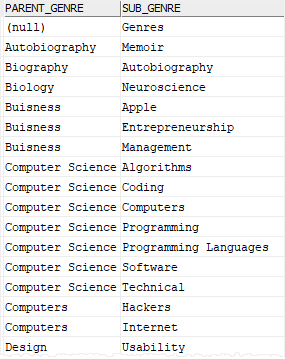Summary: in this tutorial, you will learn how to use Db2 self-join to join a table to itself to query hierarchical query or comparing rows within the same table.
Introduction to Db2 self-join
A self-join is a query in which a table is joined to itself using either INNER JOIN or LEFT JOIN clause. When you reference a table twice in a query, you have to use the table aliases.
The following illustrates the syntax of a self-join in Db2:
SELECT
select_list
FROM
table_name t1
{LEFT | INNER} JOIN table_name t2
ON join_condition;
Code language: SQL (Structured Query Language) (sql)The self-join is useful to query hierarchical data or compare rows within the same table.
Db2 Self-Join examples
See the following genres table from the sample database:

In this table, the parent_id column references to the genre_id column to establish a parent-child relationship.
It means that for a genre you can use the value in the parent_id column to find its corresponding parent genre. The top genre has NULL in the parent_id column.
This query joins the genres table to itself by comparing values in the genre_id and parent_id columns. It returns all genres and their corresponding parent genres in the hierarchy of the genres:
SELECT
p.genre parent_genre,
c.genre sub_genre
FROM
genres c
INNER JOIN genres p
ON p.genre_id = c.parent_id
ORDER BY
parent_genre,
sub_genre;
Code language: SQL (Structured Query Language) (sql)Here is the partial output:

In this example, the c and p are the table aliases for child and parent respectively.
To include the top genre in the result set, you need to use the LEFT JOIN instead of the INNER JOIN as shown in the following query:
SELECT
p.genre parent_genre,
c.genre sub_genre
FROM
genres c
LEFT JOIN genres p
ON p.genre_id = c.parent_id
ORDER BY
parent_genre NULLS FIRST,
sub_genre;
Code language: SQL (Structured Query Language) (sql)The following picture shows the partial output:

In this tutorial, you have learned how to use Db2 self-join to join a table to itself using either INNER JOIN or LEFT JOIN.